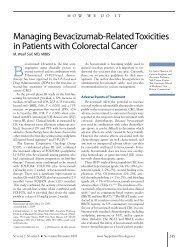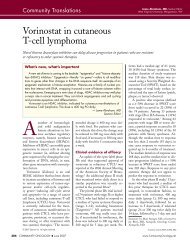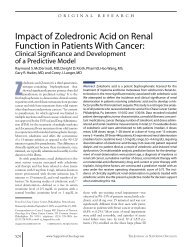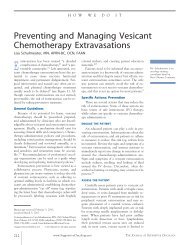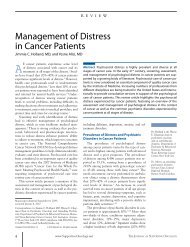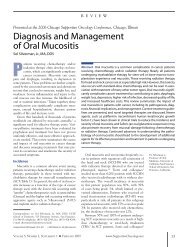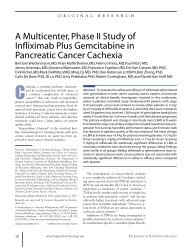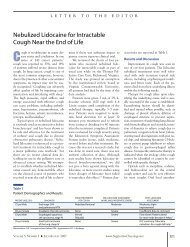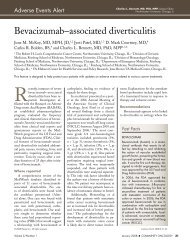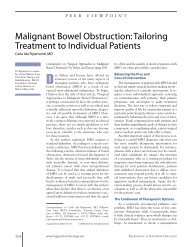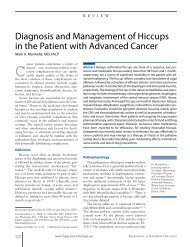Visual Analogue Scales and Assessment of Quality of Life in Cancer
Visual Analogue Scales and Assessment of Quality of Life in Cancer
Visual Analogue Scales and Assessment of Quality of Life in Cancer
You also want an ePaper? Increase the reach of your titles
YUMPU automatically turns print PDFs into web optimized ePapers that Google loves.
<strong>Visual</strong> <strong>Analogue</strong> <strong>Scales</strong> <strong>and</strong> <strong>Assessment</strong> <strong>of</strong> <strong>Quality</strong> <strong>of</strong> <strong>Life</strong> <strong>in</strong> <strong>Cancer</strong><br />
Worst imag<strong>in</strong>able<br />
quality <strong>of</strong> life<br />
<strong>Life</strong> is not worth liv<strong>in</strong>g<br />
<strong>Life</strong> could not be better<br />
Perfect<br />
quality <strong>of</strong> life<br />
How are you do<strong>in</strong>g overall today?<br />
Worst possible Best possible<br />
How would you rate your well-be<strong>in</strong>g today?<br />
Very low Very high<br />
How would you rate your quality <strong>of</strong> life today?<br />
Very low Very high<br />
Figure 1 Examples <strong>of</strong> Global <strong>Quality</strong>-<strong>of</strong>-<strong>Life</strong><br />
<strong>Visual</strong> <strong>Analogue</strong> Scale<br />
highly sensitive, <strong>and</strong> reliable rat<strong>in</strong>g scales for subjective experiences.<br />
6 The ma<strong>in</strong> advantage <strong>of</strong> a vAS is that respondents<br />
may <strong>in</strong>dicate any place along the l<strong>in</strong>e rather than be restricted<br />
by categories or numbers.<br />
vASs have been used to assess cancer QOL s<strong>in</strong>ce 1976. 7<br />
This article aims to review the role <strong>of</strong> vASs <strong>in</strong> the evaluation<br />
<strong>of</strong> cancer QOL <strong>and</strong> the methodologic issues associated with<br />
their use.<br />
VASs for QOL <strong>of</strong> <strong>Cancer</strong> Patients<br />
vASs for QOL <strong>of</strong> cancer patients may be s<strong>in</strong>gle-item, global<br />
questions (eg, how is your QOL?) or multi-item scales. Multiitem<br />
scales <strong>in</strong>clude <strong>in</strong>dividual questions about many doma<strong>in</strong>s <strong>of</strong><br />
QOL (eg, symptoms, function, relationships) <strong>and</strong> may also <strong>in</strong>clude<br />
a global scale. These scales <strong>of</strong>ten have a summated score<br />
represent<strong>in</strong>g overall QOL <strong>and</strong> may have several subscale scores.<br />
S<strong>in</strong>gle-item vASs for QOL have been suggested to best represent<br />
<strong>in</strong>dividual QOL because they do not constra<strong>in</strong> responses to<br />
the doma<strong>in</strong>s determ<strong>in</strong>ed by health care providers. 5<br />
SINGLE-ITEM VASs FOR QOL<br />
Several s<strong>in</strong>gle-item vASs for QOL have been validated<br />
<strong>in</strong> oncology. They vary <strong>in</strong> design (Figure 1), with descriptors<br />
<strong>in</strong>clud<strong>in</strong>g general well-be<strong>in</strong>g, 8 life not worth liv<strong>in</strong>g, 9 physical<br />
well-be<strong>in</strong>g, 10 cop<strong>in</strong>g, 11 <strong>and</strong> QOL. 12,13 S<strong>in</strong>gle-item QOL vASs<br />
correlate well with multidimensional questionnaires. 8,9,11–14<br />
Test-retest8,12 <strong>and</strong> <strong>in</strong>terrater13 reliability have also been demonstrated.<br />
vASs are responsive to chemotherapy-related<br />
changes over time <strong>and</strong> global rat<strong>in</strong>gs <strong>of</strong> change. 10,12 S<strong>in</strong>gle-item<br />
vASs have shown improved QOL with pa<strong>in</strong> relief, 15,16 stable<br />
QOL <strong>in</strong> patients <strong>in</strong> hospice care, 17 <strong>and</strong> response to structured<br />
<strong>in</strong>tervention dur<strong>in</strong>g radiotherapy. 18<br />
One issue with s<strong>in</strong>gle-item vASs is whether a multidimensional<br />
concept like QOL can be captured <strong>in</strong> a s<strong>in</strong>gle l<strong>in</strong>e.<br />
S<strong>in</strong>gle-item scales do not evaluate the doma<strong>in</strong>s contribut<strong>in</strong>g<br />
to QOL <strong>and</strong> thus provide no <strong>in</strong>formation expla<strong>in</strong><strong>in</strong>g the overall<br />
rat<strong>in</strong>g. However, many multidimensional <strong>in</strong>struments rely<br />
on experts to determ<strong>in</strong>e doma<strong>in</strong>s <strong>and</strong> their weight<strong>in</strong>g; they<br />
may not truly represent doma<strong>in</strong>s important to an <strong>in</strong>dividual.<br />
S<strong>in</strong>gle-item scales leave the def<strong>in</strong>ition <strong>of</strong> QOL to the <strong>in</strong>dividual<br />
respondent.<br />
<strong>in</strong> hospice care, s<strong>in</strong>gle-item QOL correlated well with cognitive,<br />
physical, <strong>and</strong> spiritual well-be<strong>in</strong>g <strong>and</strong> social activity but<br />
not with social support. 18 Similarly, the eOrTC (european<br />
Organization for research <strong>and</strong> Treatment <strong>of</strong> <strong>Cancer</strong>) QLQ-<br />
C30 (<strong>Quality</strong>-<strong>of</strong>-<strong>Life</strong> Questionnaire Core 30) global QOL<br />
subscale (numerical) correlated moderately with physical, role,<br />
cognitive, emotional, <strong>and</strong> social function<strong>in</strong>g; fatigue; <strong>and</strong> pa<strong>in</strong><br />
doma<strong>in</strong>s but less with nausea <strong>and</strong> vomit<strong>in</strong>g. 19 The mean<strong>in</strong>g<br />
<strong>of</strong> the term “QOL” may vary by age, culture, education, <strong>and</strong><br />
language. Global <strong>in</strong>dicators (eg, treatment burden) may allow<br />
a comparison between different treatments across trials. 20,21<br />
The Spitzer Uniscale. The Spitzer Uniscale is a s<strong>in</strong>gle question:<br />
“Please rate your overall QOL.” 22,23 Orig<strong>in</strong>ally designed<br />
for physician rat<strong>in</strong>g, it is now used for both patient <strong>and</strong> observer<br />
QOL rat<strong>in</strong>gs. 23 The Spitzer Uniscale is valid, with moderate to<br />
high correlations with multidimensional QOL measures; it is<br />
sensitive to changes <strong>in</strong> performance status, symptoms, <strong>and</strong> progressive<br />
disease <strong>and</strong> correlates with survival. 23 Physician scores<br />
agree moderately with patients’ scores, although they tend to<br />
underestimate QOL. The completion rate is above 90%.<br />
respondents mark an X <strong>in</strong> a box with anchors “lowest<br />
quality to highest quality.” The orig<strong>in</strong>al Uniscale description<br />
did not specify the length <strong>of</strong> the box, nor where on the X the<br />
score was measured. Scor<strong>in</strong>g has been described as either 0–14<br />
or 0–100. Some authors adapted it to a s<strong>in</strong>gle-l<strong>in</strong>e vAS with<br />
the same anchors.<br />
MULTI-ITEM VASS FOR QOL<br />
Multiple-item vASs for cancer QOL were first described <strong>in</strong><br />
1976. 7 Ten horizontal vASs assessed physical <strong>and</strong> psychological<br />
symptoms, activity, social <strong>and</strong> role activities, <strong>and</strong> well-be<strong>in</strong>g.<br />
Scores were responsive to treatment <strong>and</strong> toxicity. Several<br />
multidimensional vAS QOL <strong>in</strong>struments have between 8 <strong>and</strong><br />
53 items. They may be general (eg, GLQ824 ) or disease-specific<br />
(Lung <strong>Cancer</strong> Symptom Scale [LCSS] 25,26 or the Prostate <strong>Cancer</strong><br />
Specific QOL <strong>in</strong>strument [PrOSQOLi]). 27–29 Although<br />
doma<strong>in</strong>s vary, they all assess pa<strong>in</strong> <strong>and</strong> appetite but less <strong>of</strong>ten<br />
nausea <strong>and</strong> fatigue. Many are lengthy, limit<strong>in</strong>g their usefulness<br />
to cl<strong>in</strong>ical trials, <strong>and</strong> are not relevant for advanced cancer or<br />
palliative populations. Completion rates are <strong>in</strong>frequently reported.<br />
when reported, they are high (80%–90%). 24,30 Family<br />
is important <strong>in</strong> the QOL <strong>of</strong> cancer patients but <strong>in</strong>frequently<br />
assessed. Similarly, spirituality is assessed <strong>in</strong> only one multi-<br />
278 www.SupportiveOncology.net th e Jo u r N A l o f su p p o rt i V e oN c o l o g y



